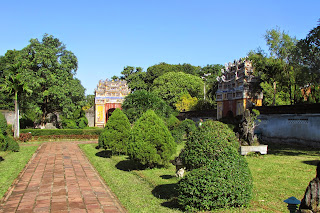Hue
Thursday, Nov 27th:
Hue (pronounced “whey”) was the Imperial Capital of the Nguyen Dynasty from 1802 (following the establishment of a united Vietnam) until 1945, when the last emperor Bao Dai abdicated and the communist regime came to power making Hanoi its capital.
After an early breakfast, we were picked up by our guide Phoac and a driver. Our first stop was the Citadel. The whole complex was built in the early 19th century and is surrounded by huge walls and moats:
Inside the Citadel was the Forbidden Purple City, which was modeled after the forbidden city in Beijing and was the main seat of the royal family.
Unfortunately the majority of the buildings were completely destroyed in the Vietnam War during the Tet offensive in 1968. Hue's location close to the border between North and South Vietnam made it a major battleground. One can still see many grenade and bullet holes in the walls and even on the bronze flower pots:
What was left of the buildings remained neglected by the communist government following the war. Only in recent years has there been a change in policy and many of the building have or are now in the process of being restored.
The whole Complex of Hue Monuments, of which the citadel is the central part, became a Unesco World Heritage Site in 1993, and Unesco has been helping in funding the restoration efforts since then.
The area inside the Citadel is huge, with extensive gardens containing numerous pagodas and several palaces surrounded by smaller moats and walls.
The facade of most of the gates and temples are beautifully decorated in intricate detail using broken porcelain pieces and beer bottles. Something you only notice once you get very close, and something we would continue to see in all the temples and the tombs here. (I have only once seen this type of decoration before in Bangkok at the Wat Arun Temple.)
After spending a couple of hours walking around citadel we were driven to the Thien Mu Pagoda, which is a Buddhist Temple situated on a small hill by the Perfume River. The large octagonal seven story tower near the entrance to the temple dates back to the 17th century. Inside several mall shrines are surrounded by beautiful gardens.
In one of the side buildings we saw the blue Morris car, which was driven by a local monk to Saigon in 1963, where he immolated himself to protest the anti Buddhist policies of the government, leading to one of the most famous photographs of the 20th century.
From here we got on a small river boat that took us upriver for about an hour to the Tombs of the Nguyen Emperors. Along the way we saw lots of small boats, completely overloaded with sand that they were barely above the water. Apparently the sand dredged from the Perfume River is considered very high quality for making concrete.The Perfume River is a very short (only 30km) yet fairly wide river. It gets its name from the aromatic scent created by flowers falling in the river from orchards upriver during autumn.
We got off the boat at the Tomb of Minh Mang, the second Emperor, which is a vast complex of pagodas, temples and palaces, surrounded by parkland and lakes. It was built between 1820 and 1841. All the pagodas are lined up in a straight line and at the end of it is a large mound surrounded by a wall. It's on this mound where the emperor is buried. But we can't see the burial site, since the gate in the wall is only opened once a year on the day of the emperor's death. During the 19th and early 20th centuries, the Vietnamese emperors were largely reduced to figureheads under French colonial rule, and that left them with little else to do but to build themselves rather vast and elaborate tombs.
We were picked up by our car here again and drove to the Tomb of Khai Dinh, which was built between 1920 and 1931. This is a really fascinating and beautiful building. It's built on the side of a steep hill, and we had to walk up a couple of hundreds steps to get to the top.
The interior of the entire building is very intricately decorated with broken pieces of porcelain and broken glass bottles. Apparently the ceiling was painting by artists with their feet.
Our final stop for the day was a beautiful little pagoda and monastery nearby, called Tu Hieu Pagoda. Nestled in a pine forest, behind the entrance gate is the half moon lake, a small artificial pond with rather large fish in it. We visited the Buddhist temple, which was first built in 1843, but restored several times during the 19th century by the monks living here and with the help of the king's eunuchs, many of which are buried here in the cemetery next to the temple.
Afterwards we drove back to Hue and were dropped off at our hotel, for some afternoon rest and photo editing. It was an amazing and beautiful day in Hue, which we finished with a lovely dinner in town and a walk back along the river.


































































No comments:
Post a Comment